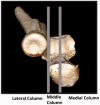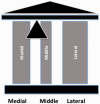Current concepts in elbow fracture dislocation
- PMID: 34394743
- PMCID: PMC8355651
- DOI: 10.1177/1758573219884010
Current concepts in elbow fracture dislocation
Abstract
Background: Elbow fracture dislocations are complex injuries that can provide a challenge for experienced surgeons. Current classifications fail to provide a comprehensive system that encompasses all of the elements and patterns seen in elbow fracture dislocations.
Methods: The commonly used elbow fracture dislocation classifications are reviewed and the three-column concept of elbow fracture dislocation is described. This concept is applied to the currently recognised injury patterns and the literature on management algorithms.
Results: Current elbow fracture dislocation classification systems only describe one element of the injury, or only include one pattern of elbow fracture dislocation. A new comprehensive classification system based on the three-column concept of elbow fracture dislocation is presented with a suggested algorithm for managing each injury pattern.
Discussion: The three-column concept may improve understanding of injury patterns and treatment and leads to a comprehensive classification of elbow fracture dislocations with algorithms to guide treatment.
Keywords: Elbow fracture dislocation; elbow instability; management.
© 2019 The British Elbow & Shoulder Society.
Conflict of interest statement
Declaration of Conflicting Interests: The author(s) declared no potential conflicts of interest with respect to the research, authorship, and/or publication of this article.
Figures









References
-
- O'Driscoll SW, Bell DF, Morrey BF. Posterolateral rotatory instability of the elbow. J Bone Joint Surg 1991; 73: 440–446. - PubMed
-
- O'Driscoll SW, Jupiter JB, King GJ, et al.The unstable elbow. Instr Course Lect 2001; 50: 89–102. - PubMed
-
- Hwang J-T, Shields MN, Berglund LJ, et al.The role of the posterior bundle of the medial collateral ligament in posteromedial rotatory instability of the elbow. Bone Joint J 2018; 100-B: 1060–1065. - PubMed
-
- Bado JL. The Monteggia lesion. Clin Orthop Relat Res 1967; 50: 71–86. - PubMed
-
- Ring D, Jupiter JB, Simpson NS. Monteggia fractures in adults. J Bone Joint Surg 1998; 80: 1733–1744. - PubMed
LinkOut - more resources
Full Text Sources
